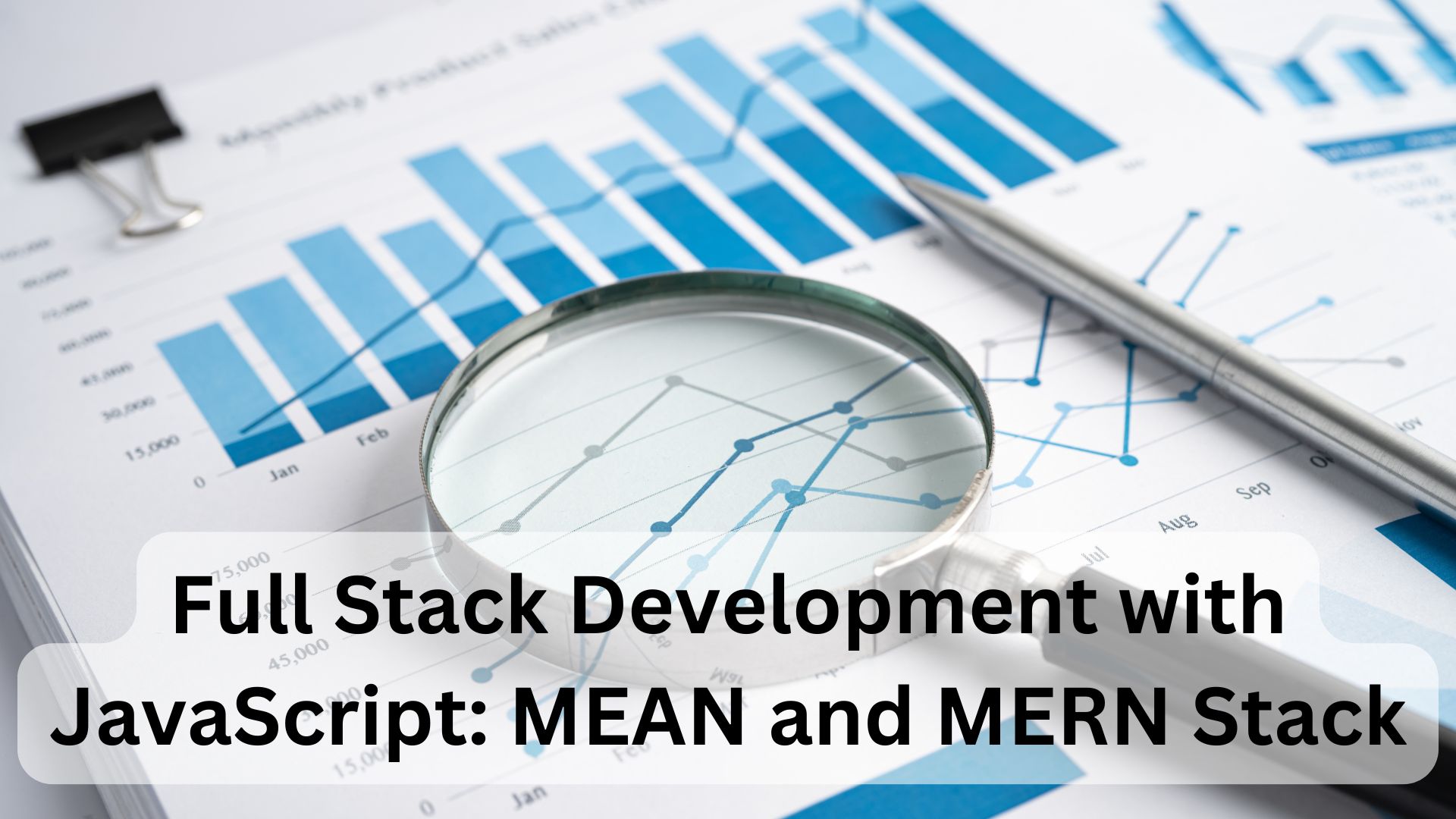Full stack development involves creating both the front-end and back-end of web applications, providing a complete solution from user interface to server-side logic. It requires a versatile skill set encompassing various technologies and frameworks. JavaScript has emerged as a leading language for full stack development due to its ability to handle both client-side and server-side tasks efficiently.
In the realm of JavaScript, the MEAN and MERN stacks are two popular technology stacks that utilize JavaScript throughout the entire development process. These stacks offer a unified approach to building robust web applications, allowing developers to use a single language for both front-end and back-end development, which streamlines the development process and improves code consistency.
MEAN Stack: This stack includes MongoDB, Express.js, Angular, and Node.js. MongoDB is a NoSQL database that handles data storage, while Node.js provides the server-side runtime environment. Express.js is a minimalistic framework that runs on Node.js and facilitates server-side logic, and Angular is a powerful front-end framework that creates dynamic user interfaces. Together, these technologies create a cohesive environment for developing scalable and maintainable web applications.
MERN Stack: Similar to MEAN, the MERN stack consists of MongoDB, Express.js, React.js, and Node.js. The primary difference is the use of React.js instead of Angular. React.js, developed by Facebook, is a popular library for building user interfaces with a focus on component-based architecture. This stack offers a flexible and efficient way to manage the state and rendering of complex user interfaces.
Both stacks are highly regarded for their efficiency and performance, but the choice between MEAN and MERN often depends on the developer’s preference for Angular or React and the specific requirements of the project.
Understanding the MEAN Stack
The MEAN stack is a powerful collection of technologies used for building modern web applications. It includes MongoDB, Express.js, Angular, and Node.js, each playing a specific role in the stack:
- MongoDB: MongoDB is a NoSQL database designed for handling large volumes of unstructured data. It stores data in flexible, JSON-like documents, making it ideal for applications that require scalability and quick data retrieval. MongoDB’s schema-less nature allows for rapid iteration and adjustment of data structures, which is particularly useful in dynamic development environments.
- Express.js: Express.js is a lightweight and flexible Node.js web application framework that simplifies the creation of server-side applications. It provides robust features for handling HTTP requests, middleware integration, and routing. Express.js acts as the bridge between the client-side and server-side, managing data flow and business logic.
- Angular: Angular, developed by Google, is a comprehensive front-end framework that enables developers to build dynamic, single-page applications (SPAs). Angular’s two-way data binding and dependency injection features streamline the development process by automatically synchronizing the model and the view. It also offers tools for building complex user interfaces with reusable components and modular architecture.
- Node.js: Node.js is a JavaScript runtime built on Chrome’s V8 engine that allows developers to run JavaScript code on the server-side. It provides a non-blocking, event-driven architecture that makes it highly efficient for handling asynchronous operations and scalable network applications. Node.js serves as the backbone of the MEAN stack, running Express.js and connecting with MongoDB.
Together, these technologies create a cohesive stack that allows developers to build end-to-end web applications using JavaScript. The MEAN stack’s advantage lies in its full-stack approach, providing a consistent development environment and reducing the learning curve by using a single language across the entire stack.
MongoDB: The NoSQL Database
MongoDB is a NoSQL database that plays a crucial role in both the MEAN and MERN stacks. It is designed to handle large volumes of data with flexibility and scalability, distinguishing itself from traditional relational databases. Here’s an overview of MongoDB’s key features and its role in the JavaScript full stack:
- Document-Oriented Storage: MongoDB stores data in JSON-like documents, known as BSON (Binary JSON). This format allows for a more flexible schema compared to traditional relational databases, where data is stored in fixed tables with predefined columns. Document-oriented storage makes MongoDB well-suited for applications with rapidly changing data structures or where data varies from document to document.
- Scalability: MongoDB’s architecture is designed for horizontal scalability. It supports sharding, which distributes data across multiple servers to handle large datasets and high throughput. This feature is critical for applications that need to scale seamlessly as user data grows.
- Querying and Indexing: MongoDB provides powerful querying capabilities, allowing developers to perform complex searches and aggregations. It supports a range of queries, including field searches, range queries, and text searches. MongoDB also offers indexing options to improve query performance, such as single-field and compound indexes.
- Integration with JavaScript: As a JavaScript-based stack, the MEAN and MERN stacks benefit from MongoDB’s compatibility with JavaScript and JSON. MongoDB’s query language and data format align seamlessly with JavaScript, making it easier to work with data throughout the application. This integration enhances development efficiency and ensures consistent data handling across the stack.
In summary, MongoDB’s flexibility, scalability, and compatibility with JavaScript make it a key component of the MEAN and MERN stacks, providing a robust foundation for modern web applications.
Node.js: The Server-Side Runtime
Node.js is a crucial component in both the MEAN and MERN stacks, serving as the server-side runtime environment. Built on Chrome’s V8 JavaScript engine, Node.js enables developers to execute JavaScript code on the server, offering several key benefits:
- Non-Blocking, Event-Driven Architecture: Node.js utilizes an event-driven, non-blocking I/O model, which allows it to handle multiple operations concurrently without waiting for one operation to complete before starting another. This architecture makes Node.js highly efficient and capable of managing large volumes of requests with minimal resource consumption, ideal for real-time applications and scalable services.
- Single Programming Language: By using JavaScript for both client-side and server-side code, Node.js streamlines development. Developers can write and maintain code in a single language, reducing context-switching and promoting code reusability across the stack.
- Rich Ecosystem and Package Management: Node.js is supported by a robust ecosystem of libraries and tools available through npm (Node Package Manager). npm provides access to a vast repository of modules and packages, enabling developers to quickly integrate functionality and accelerate development.
- Integration with Express.js: Node.js serves as the runtime environment for Express.js, a minimalistic framework that simplifies server-side logic and routing. Express.js leverages Node.js’s capabilities to create efficient, scalable server applications, handling HTTP requests and responses with ease.
Overall, Node.js’s performance, versatility, and integration with JavaScript frameworks make it an essential component of full stack development, enhancing the capabilities of both MEAN and MERN stacks.
Angular vs. React: Frontend Frameworks
Angular and React are two popular front-end technologies used in the MEAN and MERN stacks, respectively. Each framework has unique features and advantages:
- Angular: Developed by Google, Angular is a comprehensive front-end framework known for its two-way data binding, dependency injection, and modular architecture. Two-way data binding ensures that changes in the user interface are reflected in the model and vice versa, simplifying data synchronization. Angular’s dependency injection system facilitates the management of services and components, promoting code modularity and testability. Angular’s opinionated structure provides a complete solution for building robust applications but may involve a steeper learning curve due to its extensive features.
- React: Created by Facebook, React is a library for building user interfaces with a component-based architecture. React focuses on efficiently updating and rendering components using a virtual DOM, which enhances performance by minimizing direct interactions with the actual DOM. React’s flexibility allows developers to choose their own libraries for state management, routing, and other functionalities, providing more control over the development process. React’s learning curve is generally considered more accessible, particularly for those familiar with JavaScript.
Choosing between Angular and React depends on project requirements and developer preferences. Angular offers a complete framework with built-in solutions for various aspects of application development, while React provides a more flexible and lightweight approach, allowing for greater customization.
Conclusion
The MEAN and MERN stacks offer powerful frameworks for full stack development, leveraging JavaScript across both client and server sides to build dynamic, scalable web applications. While MEAN uses Angular for front-end development, MERN employs React, each providing distinct advantages based on project needs and developer preferences. Mastering these stacks enables developers to create comprehensive solutions with a unified technology stack. For those eager to deepen their expertise in full stack development, enrolling in a Offline Full Stack Developer Training in Delhi, Ludhiana, goa, etc, can provide hands-on experience with these technologies, preparing them for successful careers in modern web development.



